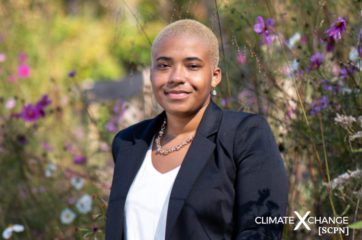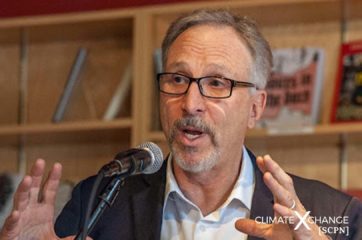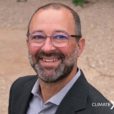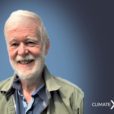All across the country, members of our State Climate Policy Network (SCPN) are fighting to make an impact on climate change in their communities. We have individuals in our Network from all 50 states, each experiencing climate change differently in their local areas and finding unique solutions to build resiliency efforts.
Theodora Okiro currently works to expand access to solar power at Nexamp Inc., advocating for innovative and equitable policy solutions to drive the clean energy transition, particularly for vulnerable populations. She holds a Master of Public Administration degree from the University of Pennsylvania and a Bachelor of Arts in history from the University of Illinois at Chicago. In 2020, Okiro was a recipient of Energy News Network’s “40 under 40” award, which recognizes emerging leaders and their work in the United States’ transition to a clean energy economy. Her work has been featured in Reuters, Yale Climate Connections, and the Environmental Law Institute.
Disclaimer: This spotlight conversation is based on the individual’s views and does not necessarily reflect the views of Nexamp. This interview has been lightly edited for clarity and brevity.
Raihan Rashidi
Welcome and thank you for being here, Theodora! I wanted to first congratulate you for being an honoree for Energy News Network’s 40 under 40 Award in 2020.
Theodora Okiro
Thank you so much!
Raihan Rashidi
Can you share a little bit about your background and what led to where you are today?
Theodora Okiro
Absolutely! Going back to where it all started — I was born in the Bronx in New York City, and lived there for six to seven years. Growing up there, that was my reality and that was all I knew. Looking back, I do recall conversations about the peaker plants located on the Hudson River that affected the community’s air and water. We lived in a small apartment where the radiators were not at all energy efficient — you could have it on all day and all night but still be cold. I remember that even though my family was middle-class, the utility bills were always a sticking point. Then, when I was seven to eight years old, I moved to Nigeria where my family is originally from. Most of Sub-Saharan Africa, to this day, suffers from what the United Nations calls energy poverty. This means that there is little to no access to electricity. A vast number of the population has to rely on dirty fuels like kerosene lamps and diesel, which we know not only contributes to carbon emissions, but also is not safe to breathe. I did my school work late at night with a kerosene lamp, and my experience with energy poverty really stayed with me.
It was not until I was in graduate school at the University of Pennsylvania that I discovered opportunities to work in policy that addressed the problems I faced. I worked at the Energy Research Center on campus and was exposed to the study of environmental injustice, something I grew up experiencing but never knowing the term for it. [These experiences] made me realize that there are opportunities to address some of the things I went through when I was younger. When you add climate change into the picture, I recognize that the communities I grew up in were and still are disproportionately affected by the climate crisis. I was spurred to continue down this career path.
All of that led me back to Illinois. After graduate school, I worked as a clean energy consultant to help implement the energy efficiency allowances for the Future Energy Jobs Act (FEJA), which was passed in 2016. I worked to promote access to energy efficiency programs for low-income communities for about two years. I then joined Nexamp, which is my current role. Working to catalyze and sustain community solar markets in the midwest region, I engage with external stakeholders such as policymakers as well as community and advocacy organizations. Nexamp has around 25 community solar projects in Illinois, so I work to ensure the process goes smoothly from a policy standpoint. My focus areas are on environmental justice and energy justice — ensuring that there is access to clean energy for every community, especially those that are often more disadvantaged by inequities in the past and even till today.
Raihan Rashidi
Your work with Nexamp focuses a lot on community solar. Based on your experiences working with developers, local governments, communities, and others, what are the barriers of clean energy adoption that you typically see?
Theodora Okiro
There are numerous barriers, and they are typically implicated in communities of color and low-income communities. The number one barrier is the knowledge gap where a lot of these folks are not aware that these clean energy programs exist, how they work, and how they could benefit from them. The knowledge gap adds another layer of challenge for communities where English is not their first language.
The structure of certain clean energy programs can also be a challenge. For most, you have to own your home or be financially well-off. This is where programs like community solar are really important as you do not have to own a home to participate, so renters or transient folks can still have easier access to clean energy. Community solar really is a community shared energy program but, again, a lot of people still do not know what it is.
Another hurdle is that frontline communities often do not have a seat at the decision-making table when policies or programs are put into place. In turn, these policies are created in a manner that is not as mindful, inclusive, or accessible. Take credit scores, for instance. Nexamp has recognized that this is a specific barrier to the adoption of clean energy programs. As a result, Nexamp does not ask for credit scores to participate in our community solar programs.
We should urgently work to break down these barriers in order to transition to a clean energy future that is truly equitable. It is important to remember that terms like community solar or energy efficiency might not be accessible to some folks. So, how do we work with community organizations and advocates to ensure that they are in the room to shape better policies and programs and appropriately translate them to their respective community members? Energy inequity really is a multipronged issue that needs multipronged solutions.
Raihan Rashidi
As you work on advancing clean energy policy, what are some projects or policies that Nexamp has worked on that you want to highlight that have increased access to solar and storage?
Theodora Okiro
We prioritize policies that are democratic in nature — ones that improve and increase access not only to our programs, but to clean energy programs in general. One of our main policy focus areas is customer-friendly net metering policies. Net metering is a policy where residents or commercial entities that generate more solar energy than they use are able to sell it back to the grid. This mechanism is not always as customer-friendly as it could be nationwide, but we work to stabilize this policy to ensure that customers continue to benefit from it. One great thing about it is its opportunity for family wealth-building. Imagine a local non-profit or church that has rooftop solar and they are able to generate revenue by selling their excess power — it is a source of income that they would not have had otherwise. Educating policymakers nationwide on this program continues to be one of our priorities.
Another project we work to promote is energy storage, what I call an up-and-coming technology since very few states have incentives to stimulate its adoption. These energy storage programs are key in promoting resiliency and sustainability in communities. When you look at places like Puerto Rico and Texas that, in the past year or two, have experienced devastating storms and extreme weather, we saw that families with backup storage via their electric charging vehicles were able to ensure that their homes as well as critical health equipment remain powered. Energy storage is one key way of achieving resilience as extreme weather patterns brought on by climate change intensifies. If each church or school can have energy storage backup, that could be critical in ensuring communities are able to survive and thrive after a disaster occurs. Communities in Puerto Rico have been investing in critical energy storage infrastructure because they realized the salient role it played during the recovery from Hurricane Maria.
I believe policies that we are fighting for in net metering and energy storage tackle some of the endemic problems that exist today when it comes to income inequality and climate change, as we are seeking to build community wealth and resiliency. The goal is to reduce, if not avoid, too much reliance on the grid that sometimes fails, and for communities to be able to sustain themselves.
Raihan Rashidi
Tying back to your point on building community wealth and resiliency, can you share on how we can build energy systems that address social vulnerabilities and injustices to ensure energy democracy that truly benefits and uplifts communities, and not just “more solar panels and more wind turbines”?
Theodora Okiro
I think the most important aspect is listening to the communities, and you will be surprised at how this does not happen as often as it should or at all. The communities know what they need and they can offer solutions and ideas to combat the energy, environmental, health, social, and economic challenges that they face locally.
If we keep going with a one-size-fits-all approach, it is not going to work because energy democracy looks different in every community. Policymakers should listen to their constituents and stop implementing widespread policies that will probably not be as effective. Energy democracy comes down to hearing the voices of the people and using their ideas to create policies that are able to address and tackle the issues at hand.
Raihan Rashidi
How do you see the clean energy transition progressing in the Midwest, and how is it different from other parts of the country?
Theodora Okiro
I see some similarities, but there are distinct differences when compared with other parts of the nation. Take Illinois for example, when FEJA was passed in 2016, it was hailed as an innovative, forward-thinking, and equitable legislation. It has been successful in many instances, but it could have been more effective in other aspects. Simultaneously, we acknowledge that the midwest is still a large producer of coal and this unfortunately continues to pollute our communities. There is a paradox there that policymakers and environmentalists are trying to grapple with because, while we recognize that coal plants really are economic engines for many communities here, these fossil fuels are still polluting the communities and ones adjacent to them.
In Illinois, we are advocating for a successor legislation for FEJA that unfortunately got derailed this past session due to disagreements over decarbonization language. Luckily there is still momentum going on this effort, but this really is a snapshot of what we are grappling with as a region. We want to move forward and tackle climate change, but we are still held back with the reality that states here are still coal producers. The goal is to find the balance of revitalizing local economies while transitioning to a clean energy economy. It comes down to working with entities involved and proposing opportunities to ensure coal workers are included in the energy transition and are not left behind.
Raihan Rashidi
That is an important part of environmental justice as well — making sure that fossil fuel workers and their families are not left behind. Iowa is also in the same boat because the state is leading in wind energy, but still produces uneconomical coal that is exported, as it exceeds the state’s electricity demand. It unnecessarily impacts Iowans’ health, environment, and economy, yet some utilities are in denial and refuse to have clear retirement plans for the plants and workers.
Theodora Okiro
Right, we need strong policies and effective plans that achieve our goals of a just transition. That is the point of talking with communities and strategizing what plans would work and what wouldn’t.
Raihan Rashidi
What can organizations like Climate XChange and other advocates do to help your work in advancing a clean energy future that is equitable and resilient?
Theodora Okiro
It is imperative that organizations like Climate XChange establish a platform for frontline communities and organizations to share their stories and policy ideas. I have been in situations where policymakers look at frontline advocates as not sophisticated or knowledgeable enough in policy, yet the irony is that they are the ones who are experiencing climate injustices. So who better to spur ideas to address the challenges than these folks that know the problems day in and day out?
Secondly, continue to educate and raise awareness on climate policies and programs. The inaccessibility to such programs prohibits communities from understanding how they can benefit from the initiatives, which makes a policy fundamentally ineffective. By translating policies into digestible and accessible formats, and in a way that resonates with the specific community, we can reduce the knowledge gap. While low-income communities and communities of color recognize the problems that they face, their attention is not always focused on these particular issues due to other injustices that they face in society. It is up to us to ensure that we are working in their favor, while at the same time recognizing the many barriers that they face on a daily basis.
Raihan Rashidi
I want to thank you for sharing your insights and highlighting the importance of approaching energy policy from an environmental justice lens. Before we wrap up, do you have anything else you’d like to share?
Theodora Okiro
Another thing that we need to be better at as an industry is including the younger generation in the decision-making process, as their future will be impacted the most by the policies we create today. I would hate to come to a point where there is a schism between the youth and us in the work that we are doing. Therefore, I think it is important to work alongside them and learn from each other in finding solutions to tackle the climate crisis.









